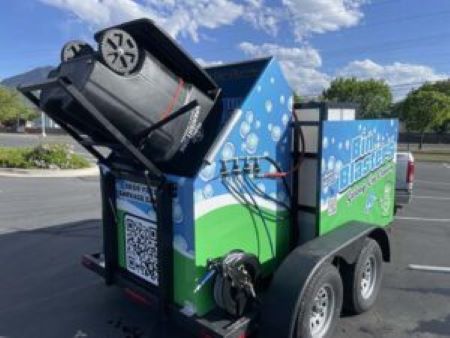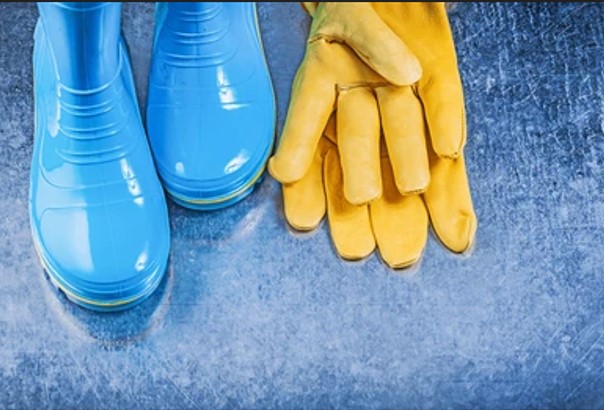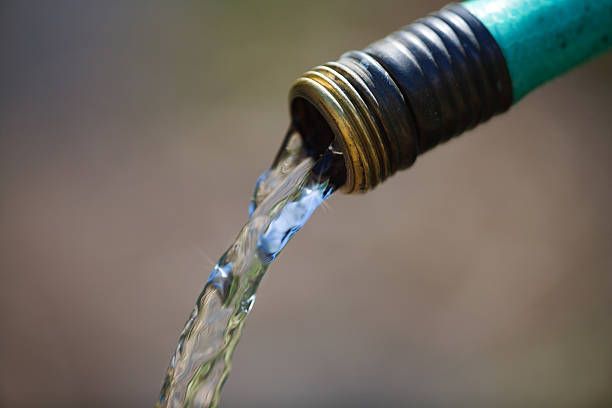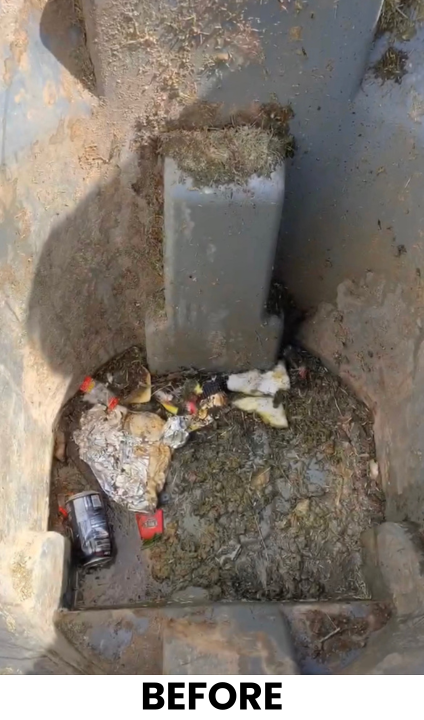Knowing how to sanitize waste bins properly is essential for eliminating odors, preventing bacteria buildup, and keeping your property clean.
Article Summary
- Invest in quality equipment to avoid messy spills and ensure effective bin cleaning.
- Use proper lifting techniques and positioning to stay clean while working.
- Understand how high-temperature water delivered by specialized equipment is key for deep cleaning and bin sanitization.
- Choose the right protective gear to keep your clothes free from grime and garbage juice.
- Recognize that professional equipment provides consistent, thorough cleaning results that manual methods can’t match.
Why Does Garbage Juice Make Such a Mess?
Alright, let’s talk about the elephant in the room… or rather, the mystery liquid at the bottom of the bin! We’ve all been there – you lift a garbage bag, and drip, drip, drip. Or worse, the bag rips. That lovely concoction, affectionately known as bin juice, is a mix of decomposing organic matter, liquids from food waste, and who knows what else. It doesn’t just stink; it stains, attracts pests, and can make a simple task feel like a biohazard cleanup.
Prevent Drips and Spills
First things first, minimizing the mess starts before you even touch the bin. Encourage homeowners (or yourself, if you’re doing your own bins!) to double-bag particularly wet or leaky trash. Tying bags securely is also crucial. When it comes to cleaning day, having equipment that securely lifts and tips the bin without sloshing the contents everywhere is a game-changer. Trust me, wrestling a heavy, leaky bin by hand is a recipe for disaster (and a ruined pair of pants).
Master Proper Lifting Technique
Even with the best bags, sometimes leaks happen. How you handle the bin matters. Trying to manhandle a full, heavy bin often leads to tilting it awkwardly, increasing the chance of spills. Early on, I learned the hard way – bending at the knees, getting a firm grip, and using smooth motions is key. But honestly, the real solution is equipment designed to do the heavy lifting for you, keeping the bin stable and contained throughout the cleaning process.
Use Professional Equipment
This is where the right gear makes all the difference. Hand scrubbing just doesn’t cut it, and trying to blast a bin with a regular hose often sends contaminated water flying everywhere. Our Bin Blasters trucks and trailers are custom-built with this exact problem in mind. They’re designed to lift, invert, and clean bins efficiently, containing the wastewater and preventing that dreaded garbage juice shower. It keeps you clean, keeps the customer’s property clean, and does a way better job.

Pro tip: Always do a quick visual check for obvious leaks or tears in bags before moving a bin. A little prevention goes a long way in avoiding a big cleanup later.
Let’s Talk About Making Bins Fresh Again
Nobody likes a stinky bin. That foul odor isn’t just unpleasant; it’s a sign of bacteria having a party in there. Getting rid of the smell is a huge part of what makes professional bin cleaning so valuable. It’s not just about making it look clean, it’s about true bin sanitization and leaving it smelling fresh.
Apply Natural Deodorizers
After the main cleaning, applying a deodorizer is key. We’re not fans of harsh chemical smells replacing garbage smells. That’s why we use things like a pleasant lavender spritz. It neutralizes odors rather than just masking them. Good equipment ensures this deodorizer is applied evenly, coating the entire interior surface for maximum effect, not just sprayed randomly in one spot.
Target Problem Areas
Some bins are worse than others, right? Maybe there’s caked-on gunk in the corners or residue clinging to the lid. Effective cleaning equipment needs to reach these spots. High-pressure spray heads designed specifically for bins can target these problem areas, ensuring the deodorizer and sanitizing agents penetrate where they’re needed most. You can’t get that kind of targeted application with a garden hose or a handheld sprayer.
Remove Stubborn Odors
Sometimes, smells really linger, especially if waste has been sitting for a while or certain types of food waste were involved. Hot water cleaning, which we’ll get into next, is crucial here, but the final deodorizing step seals the deal. It tackles those residual odors that might survive even a thorough washing. Think of it as the finishing touch that leaves the bin truly fresh, not just less stinky.
Maintain Long-lasting Freshness
The goal isn’t just a fresh smell for an hour. A proper cleaning and deodorizing process helps keep it fresh longer. By removing the odor-causing bacteria and applying a neutralizer, you’re resetting the bin’s environment. Regular cleaning, whether monthly or quarterly, prevents that deep-set funk from returning. Consistent service using professional methods makes a world of difference.
Pro tip: Baking soda can be a great natural helper between cleanings. Sprinkle some in the bottom of the bin after it’s dry to absorb moisture and odors.
Here’s How Hot Water Transforms Cleaning
Okay, let’s get into the secret sauce: hot water! When I was figuring out the best way to really clean bins, I realized cold water just wasn’t cutting it. We use water heated to 200°F on our Bin Blasters trucks, and it’s a total game-changer for getting bins truly clean and sanitized. It’s not just about rinsing; it’s about deep cleaning power.
Blast Away Bacteria
Think about washing greasy dishes. Hot water works way better, right? Same principle applies here, but we’re dealing with more than just grease. Garbage bins are breeding grounds for bacteria and other nasty microbes [5]. That 200°F water doesn’t just wash away grime; it actively kills bacteria and germs on contact. This level of heat provides a significant sanitizing effect that cold water simply can’t achieve, contributing directly to effective bin sanitization.
Break Down Grease
Grease, oils, and sticky residues are common culprits in dirty bins. They trap dirt and smells, making the bin harder to clean over time. Hot water excels at melting and breaking down these substances. Our specialized spray heads deliver that hot water with enough pressure to cut through the gunk, lifting it off the bin surface so it can be easily washed away. You see the difference immediately.
Sanitize Every Surface
It’s not enough to just clean the bottom. Lids, handles, sides, nooks, and crannies – they all need attention. Professional equipment with rotating, high-pressure spray heads ensures that hot, sanitizing water reaches every square inch of the bin’s interior. This comprehensive coverage is crucial for eliminating hidden germs and ensuring a truly sanitized container. You can learn more about how our service works at Bin Blasters.
Eliminate Hidden Germs
Cold water might rinse away loose debris, but it often leaves behind a microscopic film of germs. Hot water cleaning provides a level of sanitation that helps prevent the rapid regrowth of bacteria and mold [6]. This means the bin stays cleaner and fresher for longer after the service. It’s about tackling the root cause of the stink and grime, not just the surface appearance.
Pro tip: Always ensure the bin is completely empty before cleaning – stray garbage prevents the hot water from reaching all surfaces effectively.
Let’s Keep Your Clothes Clean While Working
Nobody wants to end their workday smelling like yesterday’s garbage, right? One of the biggest turnoffs when cleaning bins manually is how messy it gets. You’re leaning over, splashing water, dealing with potential drips… it’s easy to end up wearing half the grime you’re trying to remove. That’s why having the right setup is critical, not just for cleaning efficiency, but for keeping yourself presentable (and avoiding angry looks from your significant other when you get home!).
Choose Protective Gear
Even with the best equipment, some basic protection is smart. Think waterproof boots, maybe some splash-resistant pants or an apron. Gloves are a must. It’s not about looking like you’re heading into a hazmat zone, but practical gear makes a difference. When I started, I ruined so many pairs of shoes and jeans! Investing a little in protective wear saves you money and hassle in the long run. It’s just part of being a pro.

Position Bins Correctly
How you (or your equipment) handles the bin matters. If you’re manually cleaning, avoid positioning yourself directly downhill or downwind from where the water will run off. With professional equipment like ours, the truck does the work. The bin is lifted and contained, directing the dirty water into a holding tank, not onto the street or your shoes. Proper positioning minimizes splash-back and keeps the work area (and you) much cleaner.
Avoid Splash Zones
This ties into positioning. High-pressure water, even contained, can create some mist or splash. Good equipment design minimizes this. Our systems are built to keep the cleaning process largely enclosed while the bin is inverted inside the cleaning hopper. This drastically reduces the ‘splash zone’ compared to open-air pressure washing. If you’re considering getting into this business, look at how different equipment handles water containment – it’s a huge factor for staying clean and compliant. Thinking about starting your own bin cleaning route? Check out the Bin Blasters franchise opportunity.
Pro tip: Keep a clean towel or wipes handy in your truck. A quick wipe-down of your hands or face can make a big difference in feeling fresh throughout the day.
Here’s What Professional Equipment Delivers
So, we’ve talked about the mess, the smells, and staying clean. The common thread? Professional equipment. When I spent years tinkering and building my own rigs, it was all about solving these problems. You can clean bins with a brush and hose, but it’s slow, messy, and frankly, doesn’t do a great job on the really tough stuff. Investing in specialized gear is what separates the pros from the amateurs.
Access Hard-to-reach Spots
Think about the bottom corners of a bin, or the inside lip of the lid. These areas collect gunk and are awkward to clean manually. Professional systems use: * Rotating Spray Heads: Designed to blast water and cleaning solutions into every nook and cranny. * Optimized Angles: Ensure water hits surfaces effectively, not just splashing around. * Consistent Pressure: Maintains cleaning power throughout the cycle.
This ensures a uniformly clean bin, not just the easy-to-reach parts.
Control Water Pressure
Too little pressure won’t clean effectively. Too much can potentially damage older bins or just waste water. Professional equipment allows for precise control over water pressure and temperature, optimized for bin cleaning. It’s about using the right amount of force and heat to get the job done efficiently and safely. Our custom-built trucks are dialed in for exactly this purpose.

Ensure Complete Coverage
Manual cleaning is often inconsistent. You might scrub one area harder than another, or miss spots entirely. Automated systems with specialized spray patterns are designed for complete coverage. They hit the floor, the walls, and the lid interior with equal intensity, ensuring a thorough clean and effective bin sanitization every single time. You can read more about our approach and the franchise system we built around this technology about Bin Blasters Franchising.
Maintain Consistent Results
Customers expect the same high level of clean every time. Professional equipment delivers that consistency. Whether it’s the first bin of the day or the last, the process and results are the same. This reliability builds customer trust and is essential for growing a recurring revenue business. Trying to achieve that consistency manually, especially on a busy route, is incredibly difficult.
Pro tip: Regularly inspect and maintain your equipment’s nozzles and spray heads. Clogs or wear can significantly impact cleaning performance and coverage.
Conclusion: How to Keep Your Bins Properly Sanitized
So, what’s the bottom line? Cleaning garbage cans effectively and efficiently really boils down to having the right tools for the job. Trying to tackle baked-on grime and nasty bacteria with just a hose and brush is often a losing battle – not to mention a messy one! Proper bin sanitization requires more power and precision.
Using specialized equipment that delivers high-pressure, high-temperature water is key to blasting away germs, eliminating odors, and getting into every corner. It keeps you cleaner, works faster, and provides consistent, professional results that customers appreciate. It transforms bin cleaning from a dreaded chore into a streamlined service.
Whether you’re tired of your own stinky bins or thinking about starting a service, remember the difference professional gear makes. If you’re curious about the equipment and systems that make Bin Blasters successful, feel free to contact Bin Blasters Franchising – we love talking shop!
Frequently Asked Questions
- Q: Why is professional equipment better than just using a hose?
- A: Professional equipment uses high-pressure, high-temperature (often 200°F) water to effectively kill bacteria, break down grease, and reach all areas of the bin. It also contains the dirty water, preventing messes and keeping the operator cleaner.
- Q: How does hot water help with bin sanitization?
- A: Water heated to high temperatures (like 200°F) kills most common bacteria and viruses on contact, providing a level of sanitation that cold water cannot achieve. This helps eliminate odors at their source and prevents rapid regrowth of germs.
- Q: Can the cleaning process damage my garbage cans?
- A: Reputable services use equipment designed specifically for bin cleaning, with pressure levels optimized to clean effectively without damaging standard municipal bins. Consistent, extremely high pressure not intended for bins could potentially cause issues, which is why professional gear is calibrated correctly.
- Q: How important is containing the wastewater during cleaning?
- A: Very important! Wastewater from bin cleaning contains bacteria, grime, and cleaning agents. Professional systems capture this water, preventing it from running into storm drains or onto the property, which is more environmentally responsible and often required by local regulations.
- Q: What makes Bin Blasters’ equipment special?
- A: Our equipment is custom-built based on years of experience. It’s designed for efficiency, safety, and effectiveness, incorporating features like high-temperature water, specialized spray heads for full coverage, and wastewater recovery systems to deliver a superior clean while keeping operators and the environment safe.
More interesting posts:


